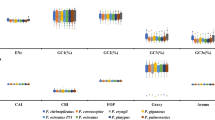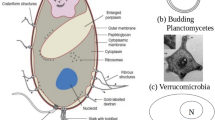Abstract
Mycoplasmas are parasitic bacteria with small genomes. Since parasitic bacteria need to adapt themselves to their hosts, there is a possibility that some genes evolved under species-specific constraint. We assume that Ureaplasma parvum has candidate genes that evolved in a species-specific manner in its genome. Here we examined synonymous-to-nonsynonymous substitution ratios (ω) of the 143 mycoplasma-orthologous genes of Ureaplasma and other mycoplasmas using branch models. As a result, the model allowing for Ureaplasma branch-specific ω in addition to ω of other mycoplasmas was significantly supported in 16 genes. First, the Ureaplasma-specific model was significantly supported in the genes encoding a transcription elongation factor and a transcription terminator factor, suggesting that transcription-related genes of Ureaplasma have evolved in a unique manner compared to those of other mycoplasmas. Second, the Ureaplasma-specific model was significantly supported in the gene encoding uracil-DNA glycosylase. In addition, the ω value of the gene in the Ureaplasma lineage was approximately 30-fold lower than those of other lineages, suggesting that uracil-DNA glycosylase of Ureaplasma evolved under stronger functional constraint than those of other mycoplasmas. Finally, three glycolytic genes of Ureaplasma were suggested to have evolved under relaxed selection. Among mycoplasmas, only Ureaplasma has urease and synthesizes ATPs via hydrolysis of urea. This raises the possibility that Ureaplasma does not need a glycolysis pathway for ATP synthesis. This unique energy-producing system may be related to the Ureaplasma-specific evolution of the glycolytic genes.
Similar content being viewed by others
References
Borukhov S, Lee J, Laptenko O (2005) Bacterial transcription elongation factors: new insights into molecular mechanism of action. Mol Microbiol 55:1315–1324
Cocks BG, Brake FA, Mitchell A, Finch LR (1985) Enzymes of intermediary carbohydrate metabolism in Ureaplasma urealyticum and Mycoplasma mycoides subsp. mycoides. J Gen Microbiol 131:2129–2135
Fish RN, Kane CM (2002) Promoting elongation with transcript cleavage stimulatory factors. Biochim Biophys Acta Gene Struct Expres 1577:287–307
Glass JI, Lefkowitz EJ, Glass JS, Heiner CR, Chen EY, Cassell GH (2000) The complete sequence of the mucosal pathogen Ureaplasma urealyticum. Nature 407:757–762
Goldman N, Yang ZH (1994) Codon-based model of nucleotide substitution for protein-coding DNA-sequences. Mol Biol Evol 11:725–736
Jaffe JD, Stange-Thomann N, Smith C, DeCaprio D, Fisher S, Butler J, Calvo S, Elkins T, FitzGerald MG, Hafez N, Kodira CD, Major J, Wang S, Wilkinson J, Nicol R, Nusbaum C, Birren B, Berq HC, Church GM (2004) The complete genome and proteome of Mycoplasma mobile. Genome Res 14:1447–1461
Li WH, Gojobori T, Nei M (1981) Pseudogenes as a paradigm of neutral evolution. Nature 292:237–239
Oshima K, Nishida H (2007) Phylogenetic relationships among mycoplasmas based on the whole genomic information. J Mol Evol 65:249–258
Oshima K, Kakizawa S, Nishigawa H, Jung HY, Wei W, Suzuki S, Arashida R, Nakata D, Miyata S, Ugaki M, Namba S (2004) Reductive evolution suggested from the complete genome sequence of a plant-pathogenic phytoplasma. Nat Genet 36:27–29
Pollack JD (2001) Ureaplasma urealyticum: an opportunity for combinatorial genomics. Trend Microbiol 9:169–175
Pollack JD, Williams MV, McElhaney RN (1997) The comparative metabolism of the mollicutes (Mycoplasmas): the utility for taxonomic classification and the relationship of putative gene annotation and phylogeny to enzymatic function in the smallest free-living cells. Crit Rev Microbiol 23:269–354
Razin S, Yogev D, Naot Y (1998) Molecular biology and pathogenicity of mycoplasmas. Microbiol Mol Biol Rev 62:1094–1156
Smith DGE, Russell WC, Ingledew WJ, Thirkell D (1993) Hydrolysis of urea by Ureaplasma urealyticum generates a transmembrane potential with resultant ATP synthesis. J Bacteriol 175:3253–3258
Yang ZH (1997) PAML: a program package for phylogenetic analysis by maximum likelihood. Comput Appl Biosci 13:555–556
Yang ZH (1998) Likelihood ratio tests for detecting positive selection and application to primate lysozyme evolution. Mol Biol Evol 15:568–573
Author information
Authors and Affiliations
Corresponding author
Electronic supplementary material
Below is the link to the electronic supplementary material.
Rights and permissions
About this article
Cite this article
Oshima, K., Nishida, H. Detection of the Genes Evolving Under Ureaplasma-Specific Selection. J Mol Evol 66, 529–532 (2008). https://doi.org/10.1007/s00239-008-9106-4
Received:
Revised:
Accepted:
Published:
Issue Date:
DOI: https://doi.org/10.1007/s00239-008-9106-4




